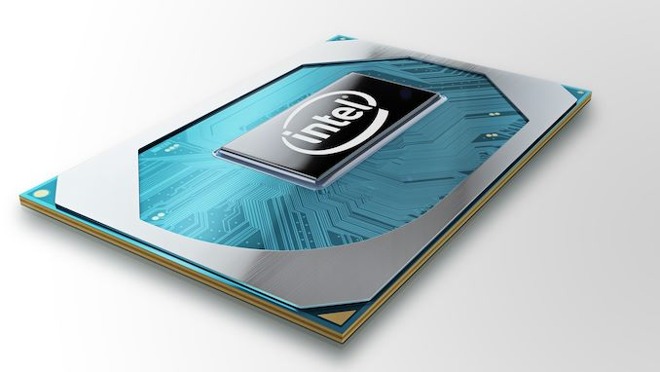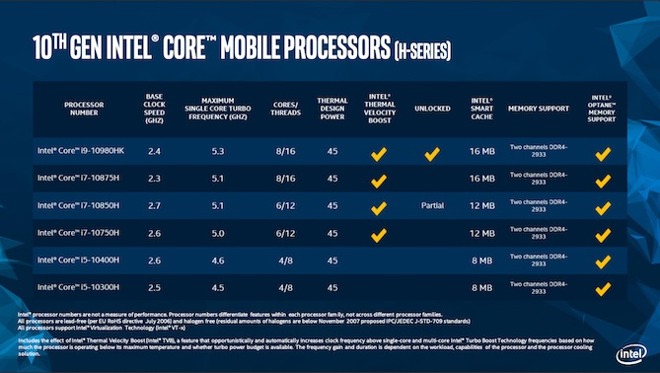New Intel 10th-gen H-series chips launched, suitable for 2020 MacBook Pro refresh
Intel has revealed specifics on a new line of 10th-generation Core processors for premium laptops -- although the improvements over what is presently available are actually relatively small.

If Apple goes with Intel processors for its MacBook Pros this year, Intel's 10th-gen chips are a likely choice.
Apple already uses 10th-generation Intel chips in its latest MacBook Air, though the ones that Intel announced today at 45W H-series processors that are aimed for higher-end notebooks like the MacBook Pro.
On the whole, the new H-series chips, part of the Comet Lake series, are fairly muted as far as upgrades. They feature minor changes to clock speed and support for Wi-Fi 6, but are still built using Intel's 14nm architecture.
Across the lineup, the base clock speeds are exactly the same as the 9th-generation chips used in the current 16-inch MacBook Pro. Turbo Boost speeds, however, now exceed 5GHz for the first time.
For example, the highest-end Core i9 chip sports a 2.4GHz clock speed but a maximum Turbo Boost of 5.3Ghz, up from 5.0GHz in the previous iteration. Intel calls the Core i9 the "world's fastest mobile processor."
Similar bumps to Turbo Boost clock speeds can be seen across the lineup. The lowest-end Intel Core i5 has a clock speed of 4.5GHz, up from 4.1GHz. A 10th-generation Core i7 clocks in at 5GHz, compared to 4.5GHz in the year-ago processor.

The Core i7-9850H and the Core i7-9750H also pack Intel's "thermal velocity boost," a feature that was restricted to the Core i9 chips last year. The highest-end Core i9 is still the only one that ships unlocked.
Intel's latest chips also feature support for two-channel DDR4-2993 memory. The previous generation supported DDR4-2666.
The chips also feature support for the 802.11ax standard, also known as Wi-Fi 6. It's a new Wi-Fi technology that should delver better speeds, increased power efficiency and lower latency than past standards, though devices must have Wi-Fi 6-compatible chips to use it.
Apple's latest iPhones and iPad Pro models already feature support for Wi-Fi 6, but none of the company's Macs do -- even the 16-inch MacBook Pro and the 2020 MacBook Air.
Of course, because Apple only launched the 16-inch MacBook Pro in November, it's likely that we're still months away from a refresh.
Furthermore, oft-accurate analyst Ming-Chi Kuo has also forecast that Apple will release its first ARM-based MacBook model with custom silicon in the fourth quarter of 2020 or the first quarter of 2021, with more ARM devices to come later that year.

If Apple goes with Intel processors for its MacBook Pros this year, Intel's 10th-gen chips are a likely choice.
Apple already uses 10th-generation Intel chips in its latest MacBook Air, though the ones that Intel announced today at 45W H-series processors that are aimed for higher-end notebooks like the MacBook Pro.
On the whole, the new H-series chips, part of the Comet Lake series, are fairly muted as far as upgrades. They feature minor changes to clock speed and support for Wi-Fi 6, but are still built using Intel's 14nm architecture.
Across the lineup, the base clock speeds are exactly the same as the 9th-generation chips used in the current 16-inch MacBook Pro. Turbo Boost speeds, however, now exceed 5GHz for the first time.
For example, the highest-end Core i9 chip sports a 2.4GHz clock speed but a maximum Turbo Boost of 5.3Ghz, up from 5.0GHz in the previous iteration. Intel calls the Core i9 the "world's fastest mobile processor."
Similar bumps to Turbo Boost clock speeds can be seen across the lineup. The lowest-end Intel Core i5 has a clock speed of 4.5GHz, up from 4.1GHz. A 10th-generation Core i7 clocks in at 5GHz, compared to 4.5GHz in the year-ago processor.

The Core i7-9850H and the Core i7-9750H also pack Intel's "thermal velocity boost," a feature that was restricted to the Core i9 chips last year. The highest-end Core i9 is still the only one that ships unlocked.
Intel's latest chips also feature support for two-channel DDR4-2993 memory. The previous generation supported DDR4-2666.
The chips also feature support for the 802.11ax standard, also known as Wi-Fi 6. It's a new Wi-Fi technology that should delver better speeds, increased power efficiency and lower latency than past standards, though devices must have Wi-Fi 6-compatible chips to use it.
Apple's latest iPhones and iPad Pro models already feature support for Wi-Fi 6, but none of the company's Macs do -- even the 16-inch MacBook Pro and the 2020 MacBook Air.
Of course, because Apple only launched the 16-inch MacBook Pro in November, it's likely that we're still months away from a refresh.
Furthermore, oft-accurate analyst Ming-Chi Kuo has also forecast that Apple will release its first ARM-based MacBook model with custom silicon in the fourth quarter of 2020 or the first quarter of 2021, with more ARM devices to come later that year.

Comments
I was shocked by the performance were seeing out of the 4000 series AMD chips. They destroying Intel chips in multicore performance while maintaining really good batter life and reasonable thermals. AMD has been killing it in the desktop space, but this is the first time(ever?) I have seen them ahead of intel in mobile. Intel is going into the fight with the higher boost clock, but AMD has better IPC and I'm willing to bet they can stay at a higher clock speed under load than intel with the smaller manufacturing process.
I know that they found references to AMD chips in a recent MacOs beta, I would love to see them shock everyone and introduce a 14 inch Macbook pro with an amd 4000 series chip.
Apple will transition away from Intel CPUs. It's inevitable because TSMC has lapped Intel in fab tech.
https://www.digitaltrends.com/laptop-reviews/asus-rog-zephyrus-g14-review/
https://www.laptopmag.com/reviews/asus-rog-zephyrus-g14
https://www.youtube.com/watch?v=ZYqG31V4qtA&feature=emb_logo
That's top end, overclocked, massive Intel laptop beating performance in a thin and light
Cost-wise, I can't really parse that as Intel has its own fabs, a whole lot of mature 14nm capacity while AMD is essentially competing for TSMC's fab capacity. How the costs play out with those two situations, who knows.
Bear in mind that Apple is about to get TSMC N5FF (5 nm) A14 SoCs for iPhones that Fall. The decider between AMD or ARM is whether Apple can outcompete others for TSMC 5 nm capacity and how long it will take AMD to get 5 nm capacity. I think Apple will be about 6 to 12 months ahead as long as iPhones are selling hundreds of millions of units per year.
In a perfect world, I would love to see Apple introduce a AMD-powered Mac with PCI4.0. The tech is there, it works, and Intel is just sitting in the corner sucking its thumb.
TR cap at 256GB is an OEM cap. Zen supports up to 2TB. If you have a new Mac Pro and don't buy the Afterburner you're nuts. That card will eat up TR's benefits, but together would be stunning in a future Mac Pro.
(Just like with ye olde Motorola.)